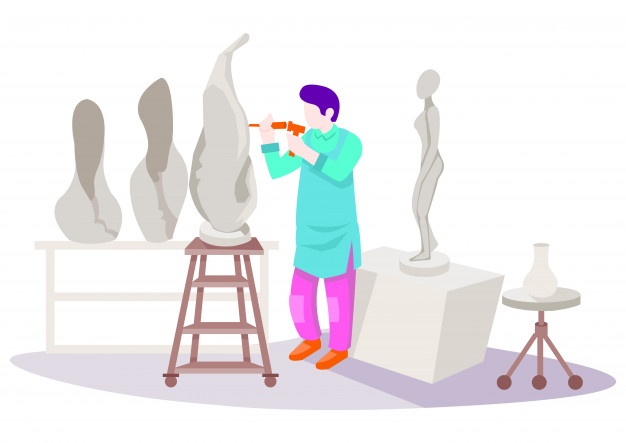My first lesson in the interconnectedness of Art resurfaces periodically. The possibility that movement evolved from sculpture is a strong one. If a bend in clay and chiselled stone influenced the tone and curve of bodies, inspiring us to dance, we can be certain that no single art can flourish or perish in isolation.
Southern Indian temples teem with ancient dancing sculptures. Until I met Mahati Kannan, I didn’t know they weren’t still. She told me they were always in motion, although, set in stone. They were dancing back then in the dexterous hands of their sculptors. They dance in our imaginations and through our bodies even now.

I walked past these treasures – some etched into the stone walls of prehistoric corridors; some fastened to them and others standing alone – timeless and grand. These sculptures, classically known as Karanas are simply explained by Mahati as “dance movements”. Perched on the cool marble floor of one such corridor, shielded from the sultry day outside, Mahati acquainted me with the spirit bouncing off the stillness, where movement is likely to have begun.
She begins,
“The Karanas are dance movements prescribed in the fourth chapter of the Natyasastra (The Fifth Veda: an ancient Indian masterwork on Drama; the first ever text to mention Dance and its execution.)
They form a unique movement vocabulary. Think of them as words in a language expressed through the body in dance. These movements have three main components called Sthānas (stances/postures), Chāris (movements of the legs), and Nritta Hastas (movements of the arms in entirety).
A combination of specific Sthānas, Chāris and Nritta Hastas will give rise to a Karana movement.
108 such movements have been prescribed in the Natyasastra.
Now, if we take the Karanas to be words, they can be put together to form phrases, sentences, even poetry. While they can be adapted to various kinds of music and even recitation, the Natyasastra gives us 32 specific combinations of these Karanas. These are called Angahāras.
Just as classic poetry has a certain grammar for the construction of verses using a specific metre, Sage Bharata gives specific Karanas to be used in each Angahāra as well as the order of movements.
But like I said, apart from the Angahāras, the Karanas have a wide scope of use in other forms of music as well.”
The Karanas came to her pretty early. But did they come easy?
“I officially started learning the Karanas when I was about 12 or 13 years old. But I was familiarised with them a lot earlier. Blessed to have been raised in a tradition that underscored their value from the beginning, exposed to them since childhood, I did find it easier learning the Karanas.
However, it still wasn’t easy. To understand each movement in my own body took a long time before I felt comfortable performing each Karana. They do need to be completely soaked into one’s body before they feel like second skin – certain enough to be performed.”
When asked how her body was conditioned over the years, she explains,
“My body was trained and prepared when I was pretty young. Although that is ideal because the young are supple and more receptive to toning, no age is off limits. You can learn a Karana if you decide you want to! There’s a safe way to approach it at any age. It could well be difficult to perform a few movements, depending on how your body has aged, how strong your body is. Even so, the malleable nature of the Karanas allow them to be customized to your physique and capability. It’s about feeling comfortable in them whilst ensuring your body doesn’t react adversely.
Learning a Karana, in my experience, is quite the same as learning a Yoga Asana. It is taught, learned and practiced with care, allowing your body to settle into it rather than be shocked by it. If you overstrain or overstretch, you can twist a muscle here or there at any age. Demanding as they were, the Karanas made a gradual entry into my body and I allowed them to roost with regular practice, correction, alignment and flow.”
Training in the Karanas sure require a strong classical foundation. When I assumed it had to come solely from Bharata Natyam, Mahati reassuringly denied that assumption,
“I have grown to watch my Guru Dr. Padma Subrahmanyam, teach students across multiple disciplines of Indian Classical Dance. No one needs to change anything about their current dance style to train in the Karanas, just like how you need not change your mother tongue to learn a new language. The beauty of these movements is that they blend in with all classical styles of dance. We’ve had students trained in Mohiniattam, Odissi, Kathak and Kuchipudi for years come and learn the Karanas with us, and they have been able to blend in the Karana movements along with the movements of their respective styles, whilst still retaining the individual unique characteristics of the two styles.
A learning of Karanas enhances your practice and performance of every Indian Classical Dance form. These are universal movements, relevant to practitioners across the board and they’re beautiful!”
There’s a ray of reminiscence and excitement on her face and she carries on,
“Looking back, I can see how my understanding of the movements has evolved since I first learned them. They look deceptively easy to perform but they require immense body control and mind-body coordination. My Guru always says, “The body is trained only to be forgotten about”, and I have experienced that especially with the Karanas. They have given me so much freedom of movement and expression, and it’s always such a joy performing them!”
I didn’t mean to darken the glimmer but I had to ask of her struggles with learning these ancient marvels. She was quick to confirm,
“To be honest, none of them are easy. One important lesson I learned is that you must feel comfortable doing the Karanas. The seemingly easy ones also have these tiny nuances that are barely noticeable but they are the ones that can make or break the beauty of the movement. It’s been a journey learning and practising the Karanas. Once you learn all of them, you’re just beginning the process. I’m constantly working on them but I’m never satisfied, and I don’t think I’ll ever be!”
The dissatisfaction doesn’t surprise me. I’ve been told of that divine dissatisfaction that afflicts artists. It propels and causes one to pause and reflect in equal measure. I simply ask her, “Why Karanas?” She counters it with another question,
“Well, that gives rise to another exploration in my mind: ‘Why do we dance?’
I would say simply because the Karanas are beautiful, aesthetic, liberating. To me, Art is that which liberates, and dancing the Karanas is highly liberating! And so, I dance!
The Natya Shastra gives a story behind why they were included, but from my simple, humble experience, the Karanas are an experience!
As for their technical purpose, since Indian dance is highly stylised, the Karanas serve a two-fold purpose. They can be used in both Nritta (Pure Dance) as well as Abhinaya (The Art of Communication). In other words, they can be performed merely as movements or, if used in the right context in the right way, communicate an idea or a concept as well. Just as we have different hand gestures in classical dance which are used in wordless communication, the Karanas too are a highly stylised language of their own.”
Having imbibed her Guru’s research, Mahati has seen similarities between the Karanas and other dance forms. Perhaps, we can attribute them to cultural cross-currents. Some of them though are entirely coincidental. She explains these parallels,
“Surely there are differences in form, technique and content and the Karanas come from a very Indian tradition and treatise. The Art of Dance, however, in itself, is universal. We all bend and stretch and lengthen and curve and leap in some way and it’s quite possible that sometimes we find ourselves moving like one another, across disciplines, borders, cultures. So long as there is joy, there is dance. Our differences barely matter and our similarities can continue to surprise!”
She wants to put in a word for the responsibility entrusted to us, young artistes…
“The Karanas are part of an ancient tradition that was unfortunately lost to the Art world for several centuries and has been painstakingly revived and reconstructed by my Guru through decades of research.
As students and practitioners of the Karanas, and as artistes, I think we all have to keep this tradition alive and not let its revival go in vain. As long as dance is relevant in this world, I feel the Karanas will be too. Every time I dance them, they feel fresh and new. And because there is something so definitely special about them, they shall and must always remain, so long as the Art of Dance remains…”
I touched a stone sculpture right then. I think it touched me too. It did.
(Our exchanges with Mahati Kannan in the lead up to this piece have been enriching and enlightening. Her intellect and commitment to Art amazes us. We need more artistes like her!)
DISCLAIMER: The content on this website is merely an opinion and not intended to malign any religion, ethnic group, organisation, company or individual. Nothing contained herein shall to any extent substitute for the independent investigations and sound judgment of the reader. While we have made every attempt to ensure the accuracy and completeness of the content contained herein, no warranty or guarantee, express or implied, is given with respect to the same. The SHOUT! Network is neither liable nor responsible to any person or entity for any errors or omissions, or for any offense caused from such content.
In addition to the above, thoughts and opinions change from time to time… we consider this a necessary consequence of having an open mind. This website is intended to provide a semi-permanent point in time snapshot and manifestation of the various topics running around our brains, and as such any thoughts and opinions expressed within out-of-date posts may not be the same, or even similar, to those we may hold today.
Feel free to challenge us, disagree with us, or tell us we’re completely nuts in the comments section of each piece. The SHOUT! Network reserves the right to delete any comment for any reason whatsoever (abusive, profane, rude, or anonymous comments) – but do SHOUT! with us, if you will.
DISCLAIMER: The SHOUT! Network welcomes guest posts on its website. The statements, views and opinions expressed within these guest posts are those of the author alone and do not necessarily represent those of The SHOUT! Network and its associated writers. Whilst we endeavour to ensure the accuracy, applicability and completeness of the content on the website; no warranty or guarantee, express or implied, is given with respect to our guest posts. The SHOUT! Network is neither liable nor responsible to any person or entity for any errors or omissions, or for any offense caused from such content. The copyright in and arising out of guest post belongs to the author alone and any liability with regards to infringement of any rights including intellectual property rights remains with them.















